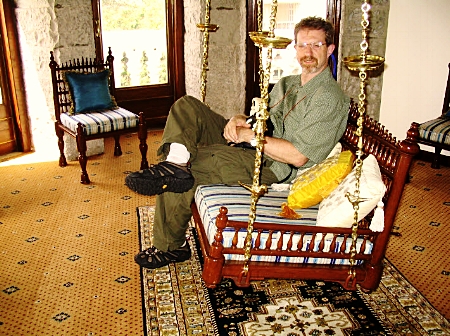4 min read
My Taj Mahal isn’t the same as yours. Yours is probably that iconic marble mausoleum seen in travel brochures and magazines in dentists' offices. My Taj Mahal is a majestic Victorian hotel overlooking the port in Mumbai, that demands your undivided attention. Here are just a few who have passed through its welcoming doors - Mahatma Gandhi, Duke Ellington, John and Yoko, Sir Mick, Brad and Angelina, “W”, the Clintons, the Obamas, me and the guys… and 9 terrorists from Pakistan.
This is the Taj Mahal Palace Hotel – the city’s first all-electric hotel that transformed then Bombay back in 1903. It was through this portal, British royalty arrived and where Governor-General Lord Mountbatten gave his farewell address. It was also here, in a suite overlooking the Arabian Sea, Ravi Shankar taught George Harrison how to play the sitar.
I also got to play here. I was fortunate enough to have the hotel’s owners as my clients… twice. So on several trips to Mumbai, I had my rooms at the Taj. I was neither rich nor famous… just lucky.
After a busy day shooting video, my crew and I would kick back in the aptly named Sea Lounge with an aptly named Bombay Gin and tonic. The lounge was bright, lit with the muted sun reflecting off the sea just out the window. The place had a vintage clubby vibe, its Indo revival style elements conjured a world that had already faded away. Guests were a mix of Indian and European, with a few Yanks like us thrown in.
Entering the hotel was like slipping into an old Hollywood movie where everyone knew how to dress and behave. The staff was so comfortable they looked like they were at home, not surprising as many had been here for thirty or forty years. Some were second and third generation at the old Taj.
But the place didn’t feel old. Rather, it was effortlessly elegant. The Taj didn’t need a dress code or a PR team. This maharajah of hotels has always stood at the intersection of luxe and cool.
John And Yoko
The first time we came to the Taj, we were assigned to photograph the hotel’s highlights - the suites, the lounges, the central floating staircase. You've probably never gotten emotional about a staircase, but then you've not yet been to the Taj. This rococo structure invoked a Victorian greenhouse spilling into the central heart of the hotel – seven floors, up and down.
We then ferried our gear from this dazzling atrium to the Rajput Suite. It was here that Mr. and Mrs. Lennon retreated for five days, asking not to be disturbed. Tramping inside, we took in the suite’s layers of gold, gauze and its many tuffets, on which to plant one’s bum. The rooms had great bones – rounded soffits and ceilings to ease the eyes wherever they landed.
In the middle of it all hung a delicate swing. Just like that. I swung on the swing. It was the swing where John and Yoko had swung. Or so I imagined.
It was around the time of their stay here that John and Yoko had publicly retreated to various hotel beds around the world to promote their ‘Bed-ins for Peace’. Their Amsterdam bed-in, lasted seven days, two days longer than their retreat here in the Rajput Suite. But their presence here still resonated with their message of peace….
The Chef’s Table
India may not be the world’s most populous country but it can easily feel like it’s the densest. You’ve heard all those crowded place expressions like ‘cheek by jowl’, ‘packed like sardines’, ‘a sea of faces’? That’s Mumbai on a good day. Personally, I love it. Ahh… the humanity.
We were filming in a dense street market with the chef from the Taj. This outing wasn’t something special done for our benefit. As a guest, you can wade into the neighborhood vegetable stalls with the chef, pick your produce, then go back to the swank hotel kitchen and cook together. What you end up with is a big family meal you can share with your friends at the Taj.
But as we were picking through our fenugreek and sarso ka saag, the cameras attracted a lot of attention. Suddenly all those packed sardines were swimming our way. I felt the press of many warm bodies and turned to greet a few hundred inquisitive faces.
Some were merely curious; others had jewelry to sell us, still others tugged at our sleeves, perhaps hoping to get a bit of western juju. Maybe they just wanted a story to tell at home that evening. Don’t we all want to have a story to share come the evening?
Like dumb-dumb tourists, we just stood there, being pawed while smiling and nodding. Our chef had no time for this. He scowled and bulldozed his way forward, parting the crowd. We grabbed onto him, escaping the horde and clutching our produce. Thus, we scampered back to the embrace of the hotel for our first cooking lesson.
Slumdogs
The Taj Mahal Palace was our Mumbai base of operations. We would roll out in the morning taking one of the thousands of tiny Tata taxis scurrying about the city. Then it would be off to a shoot.
We had another client there, an airline. They had a few 300 million dollar airplanes they wanted us to photograph, inside and out. So we Tata’ed to the airport.
Now this airport was big and modern, yet it sat next to one of the darkest neighborhoods I’ve seen. This shantytown was later made famous by the move, “Slumdog Millionaire”. Here were the alleyways that produced the movie’s very clever, very determined hero.
At one point, we drove through the neighborhood at night on its gutted road, past rows of darkened homes, lit only by occasional trash fires. Yet, when we checked our directions on the map, the place simply did not exist. It was as if it had sprouted in the dark like a mushroom.
Clearly official Mumbai didn’t want to acknowledge this impoverished neighborhood’s existence. Yet here we were, observing life all around us. Soon these streets would star in a major motion picture. And then this place would officially exist… at least for the rest of the world.
The many inhabitants of this neighborhood brought yet more contrast to our shoot. Here we were, in a state-of-the-art hanger, shooting on a 300 million dollar airliner – a Boeing 777. Yet when I stepped out to take a break, I was met by a couple of stray dogs, sniffing around. They had no collars and were clearly street dogs or the real ‘slumdogs’, if you will.
The pack had wandered in and were checking out the billion dollars’ worth of aircraft, for any scraps of food. Yet no one seemed concerned. The dogs could have peed on the planes’ expensive tires and braking systems but they were treated as regulars from the ‘hood. I gave them some crackers, which they appreciated. There was something charming and yet mildly disturbing about all of this.
This particular shoot went on forever – maybe 20 hours. Finally emerging into the bright Indian day, we stumbled back to the Taj and were welcomed back as heroes. I don’t know why but that’s how they always made us feel.
State Of Siege
Back in Los Angeles, we edited the material we had shot for the airline and our friends at the Taj. At the time, our process was to put the video on DVDs and send them to the client for their feedback. This we did and were waiting for their response when I heard the news about a terrorist attack in Mumbai. It had been highly coordinated, and it had been brutal.
Several Pakistani terrorists had seized a boat at sea and made for the shore of India. They landed in Mumbai... near the Taj. The group inflicted carnage all around the city. They struck with a ferocity that initially overwhelmed the city's resources.
At the Taj, hundreds of guests and employees were trapped or hiding. The attackers used automatic weapons and grenades. Six explosions were reported coming from the hotel and soon fires were seen burning throughout the grand old structure.
Despite the terrorists’ infiltration, fire fighters were able to free some 200 hostages through the windows. After three days of siege, a Rapid Action Force and Marine Commandos killed the nine attackers.
The death toll in the city stood at 164. At the Taj, dozens lost their lives. Some of the kind, generous people who had guided and helped us at the hotel were gone.
Several months later, I received a request to resend the video we had shot. The original materials we had sent to the Taj were lost in the fires.
The terrorists’ aim had been to 'strike a blow against Indian wealth and progress'. They had stuck a blow, but the world condemned them and their ideology. Several months later, a restored Taj Mahal Palace Hotel opened once again.
The first foreign head of state to visit the Taj after the attacks was President Barack Obama in 2010. Shortly after arriving, the President addressed hotel employees gathered in a courtyard. He shared with them:
“Mumbai is a symbol of the incredible energy and optimism that defines India in the 21st century. And ever since those horrific days two years ago, the Taj has been the symbol of the strength and the resilience of the Indian people."
People I had worked with and who were so helpful to me had lost their lives in this grand palace. For many it was their second home. Perhaps that is why I want to return to the Taj. Its warmth and attention are unrelenting.
Until then, the Taj remains for me as always, “the diamond by the sea”.
If you enjoyed this post please 'like' or leave a comment below, and share with friends. Thanks.




